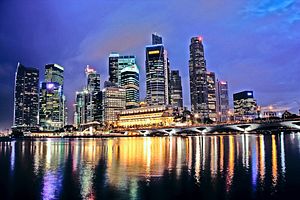Singapore and Hong Kong have topped the list of the world’s most expensive cities to live in, with Asia now accounting for half of the top 10 in line with its growing economic might.
According to the latest survey by the Economist Intelligence Unit (EIU), Singapore retained its title for the fourth straight year, with its rival Hong Kong staying second and Switzerland’s capital, Zurich taking third spot.
Tokyo, the world’s most expensive city until 2012, re-entered the top 10 thanks to a stronger yen, rising seven places to fourth, while Osaka gained nine spots to fifth. The South Korean capital of Seoul increased by two spots to sixth, with the European cities of Geneva, Paris, and Copenhagen filling the remaining top 10 places along with New York.
With the strength of the U.S. dollar moderating, the Australian cities of Sydney and Melbourne along with New Zealand’s Wellington and Auckland featured among the top 20 most expensive. Notably, the New Zealand capital climbed 26 spots to 16th, matched by Auckland’s 22 place climb.
In contrast, weakening consumption growth and a steady devaluation of the Chinese yuan saw China’s urban centers slipping down the rankings. Beijing ranked 47th most expensive, dropping 16 places, with other Chinese cities also slipping down the ranks, including Dalian, down 11 spots to 32nd, and Guangzhou, down 13 places to 69th.
Nevertheless, the report said Singapore still offered “relative value” in some categories, including such items as personal care, household goods, and domestic help, although it still remains the costliest place to buy and run a car.
In contrast, Seoul, Tokyo, and Osaka are the three most expensive cities to buy staple goods, with topping up a grocery basket in the South Korean capital costing more than 50 percent than the equivalent in New York.
The EIU found a 1 kilogram (2.2 pound) loaf of bread costs an average of $14.82 in Seoul compared to $7.95 in New York, with a bottle of table wine costing $26.54 in the South Korean capital compared to $14.74 in the U.S. city. In contrast, cigarettes are far cheaper in Asia, with a packet of 20 costing just $4.01 in Seoul and $4.45 in Tokyo compared to $14.25 in New York.
Value for Money
However, Asia also has its “value for money” cities, particularly in South Asia, with Bangalore (ranked 131st), Mumbai (127th), and New Delhi (124th) among the 10 cheapest locations.
“Income inequality means that low wages proliferate, driving down household spending and creating many tiers of pricing, as well as strong competition from a range of retail sources. This, combined with a cheap and plentiful supply of goods into cities from rural producers with short supply chains, as well as government subsidies on some products, has kept prices down, especially by Western standards,” the EIU said.
Looking ahead, the EIU said rising oil and other commodity prices could cause prices to rise in 2017, while political effects including Brexit and Trumponomics could also affect import and export prices.
“Measures in China to address growing levels of private debt are still expected to prompt slowing consumption and growth over the next two years. This could have ramifications around the world, resulting in further staged renminbi devaluations that affect the relative cost of living of Chinese cities,” the EIU said.
Conducted biannually, the EIU’s “Worldwide Cost of Living” survey compares more than 400 individual prices across 160 products and services in 133 cities worldwide.
The EIU’s survey compares to a recent survey of housing affordability, which found that Hong Kong and Sydney ranked as the world’s most unaffordable cities to buy a home, although other Asian cities such as Singapore and Tokyo were considered more economical.
The consultancy’s 2016 liveability survey ranked the Australian city of Melbourne as the world’s most liveable, with other Australian cities also ranking highly, including Adelaide (fifth) and Perth (seventh).
Pointing to the impact of economic or political disruption in some of the world’s cheapest cities, the EIU said: “Put simply, cheaper cities tend also to be less liveable.”
With the world’s urban population seen growing to 70 percent by 2050 from 55 percent in 2016, getting the balance right will be vital for policymakers. According to the United Nations, poor governance, corruption, crime, and inequality all pose obstacles to prosperity, with Asia’s “megacities” seen continuing their rise in the decade ahead.

































